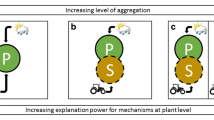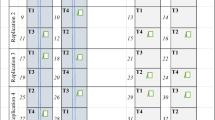Abstract
Use of literature crop coefficient (K c) values for quantifying evapotranspiration (ETc) under non-standard conditions such as plastic mulch, shallow water table, and sub-tropical conditions can lead to inaccurate ETc estimates. A 5-year experiment was conducted for fall crop growing seasons in south Florida to quantity bi-weekly ETc and K c for bell pepper grown under shallow water table and plastic mulch environments using large drainage lysimeters. The ETc values varied from 205 to 320 mm with a seasonal average of 267 mm. Average K c values for bell pepper for development, mid-season, and late stages were 1.05, 1.21, and 1.28, respectively. Higher than literature initial K c values were due to rainfall and use of sub-irrigation system to maintain artificially high water table which results in high soil moisture in the bare soil area—such high moisture results in high evaporation. The K c values from this study were statistically higher than literature values. Use of literature K c values resulted in underestimating ETc by 27–37%. The K c values would provide improved estimates of sub-irrigated pepper ETc in subtropical Florida and elsewhere with similar environment.









Similar content being viewed by others
References
Aboukhaled A, Alfaro A, Smith M (1982) Lysimeters. FAO Irrigation and drainage paper 39. Rome, Italy. Food and Agriculture Organization of United Nations
Allen RG, Smith M, Perrier A, Pereira LS (1994) An update for the definition of reference evapotranspiration. ICID Bull 43(2):1–34
Allen RG, Pereira LS, Raes D, Smith M (1998) Crop evapotranspiration. Guidelines for computing crop water requirements. FAO Irrigation and Drainage paper 56. Rome, Italy. Food and Agriculture Organization of United Nations
Ayars JE, Hutmacher RB (1994) Crop coefficients for irrigating cotton in the presence of groundwater. Irrig Sci 15(1):45–52
Bethune M, Austin N, Maher S (2001) Qualifying the water budget of irrigated rice in the Shpparton irrigation region. Aust Irrig Sci 20(3):99–105
Brown PW, Charles FM, Young MH, Thompson TL, Wierenga PJ, Kopec DM (2001) Penman monteith crop coefficients for use with desert turf systems. Crop Sci 41:1197–1206
Clark GA, Albergts EE, Stanley CD, Smajstrala AG, Zazueta FS (1996) Water requirements and crop coefficients of drip-irrigated strawberry plants. Trans ASAE 39(3):905–913
Devitt DA, Morris RL, Bowman DC (1992) Evapotranspiration, crop coefficients, and leaching fractions of irrigated desert turfgrass systems. Agron J 84:717–723
DHI (2009) MIKE SHE User Manual. Danish Hydrologic Institute, Denmark
Doorenbos J, Pruitt WO (1977) Crop water requirements. FAO Irrigation and Drainage paper 24. Food and Agriculture Organization of United Nations, Rome
Farahani HJ, Howell TA, Shuttleworth WJ, Bausch WC (2007) Evapotranspiration: Progress in Measurement and Modeling in Agriculture. Trans ASABE 50(5):1627–1638
Farahani HJ, Oweis TY, Izzi G (2008) Crop coefficient for drip-irrigated cotton in a Mediterranean environment. Irrig Sci 26:375–383
Gowing J, Konukcu F, Rose DA (2006) Evaporative flux from a shallow watertable: the influence of a vapour-liquid phase transition. J Hydrol 321:77–89
Haman DZ, Pritchard RT, Smajstrla AG, Zazueta FS, Lyrene PM (1997) Evapotranspiration and crop coefficients for young blueberries in Florida. Appl Eng Agric 13(2):209–216
Hess TM (1996) Evapotranspiration estimates for water balance scheduling in the UK. Irrig News 25:31–36
Hillel D (1980) Fundamentals of soil physiscs. Academic Press, San Diego 413 p
Hillel D (1987) The efficient use of water in irrigation: principles and practices for improving irrigation in arid and semi-arid regions. The World Bank, Washington, DC
Howell TA, Schneider AD, Jensen ME (1991) History of lysimeter design and use for evapotranspiration measurements. In: Allen RG, Howell TA, Pruitt WO, Walter IA, Jensen ME (eds) Proceeding of the International Symposium on Lysimetry, July 23–25. Honolulu, HI, USA
Howell TA, Evett SR, Tolk JA, Schneider AD (2004) Evapotranspiration of full-, deficit-irrigated, and dryland cotton on the northern Texas high Plains. J Irrig Drain Eng 130(4):277–285
Irmak S, Haman DZ, Jones JW (2002) Evaluation of class A pan coefficients for estimating reference evapotranspiration in humid location. J Irrig Drain Eng 128(3):153–159
Jaber FH, Shukla S, Srivastava S (2006) Recharge, upflux, and water table response for shallow water table conditions. Hydrol Process 20(9):1895–1907
Jensen ME, Burman RD, Allen RG (1990) Evaporation and irrigation water requirements. ASCE Manuals and Reports on Eng. Practices No. 70, Am. Soc. Civil Eng, New York, NY, p 360
Kang S, Gu B, Du T, Zhang J (2003) Crop coefficient and ratio of transpiration to evapotranspiration of winter wheat and maize in a semi humid region. Agric Water Manage 59(1):239–254
Kashyap PS, Panda RK (2001) Evaluation of evapotranspiration estimation methods and development of crop-coefficients for potato crop in a sub-humid region. Agric Water Manage 50(1):9–25
Kellman S (2009) America’s water supply: Scarcity becoming endemic. http://www.circleofblue.org/waternews/2009/world/america%E2%80%99s-water-supply-scarcity-becoming-endemic. Accessed 29 July 2011
Liudahl K, Belz DJ, Carey L, Drew RW, Fisher S, Pate R (1998) Soil survey of Collier County Area, Florida. USDA/NRCS in cooperation with the University of Florida, Institute of Food and Agricultural Sciences, Agricultural Experimental Stations and Soil Science Department; and Florida Department of Agriculture and Consumer Services
Locascio SJ (2005) Management of irrigation for vegetables: Past, present, and future. HortTechnology 15(3):482–485
Marella RL (1999) Water withdrawals, use, discharge and trends in Florida 1995. USGS Water resources investigations report 99-4002. Tallahassee, FL
Marella RL (2008) Water Use in Florida, 2005 and Trends 1950–2005. USGS Fact Sheet 2008-3080. http://pubs.usgs.gov/fs/2008/3080. Accessed 29 July 2011
Maynard DN, Hochmuth GJ, Vavrina CS, Stall WM, Kucharek TA, Webb SE, Taylor TG, Smith SA (2001) Cucurbit production in Florida. In: Vegetable production guide for Florida. Maynard DN, Olson S (eds), 27:151–178. IFAS-University of Florida, Gainesville, FL
Maynard DN, Hochmuth GJ, Vavrina CS, Stall WM, Kucharek TA, Web SE (2003) Pepper production in Florida. In: Olson M, Maynard DN (eds) Vegetable Production Guide for Florida 2002–2003. IFAS-University of Florida, Gainesville, FL, USA
McAvoy G (2008) South Florida vegetable pest and disease hotline. University of Florida, Institute of Food and Agricultural Sciences
NASS (2005) National Agriculture Statistics Service. United States Department of Agriculture Available at: http://www.nass.usda.gov. Accessed 29 July 2011
Oad R, Lusk K, Podmore T (1997) Consumptive use and return flows in urban lawn water use. J Irrig Drain Eng 123(1):62–69
Obreza TA, Pitts DJ, Parsons LR, Wheaton TA, Morgan KT (1997) Soil water holding characteristic affects citrus irrigation scheduling strategy. Proc Fla State Hortic Soc 110:36–39
Orgaz F, Fernandez MD, Bonachela S, Gallardo M, Fereres E (2005) Evapotranspiration of horticultural crops in an unheated plastic greenhouse. Agric Water Manage 72(2):81–96
Pandey PK, Pandey V (2011) Lysimeter based crop coefficients for estimation of crop evapotranspiration of black gram (Vigna Mungo L.) in sub-humid region. Int J Agric Biol Eng 4(4):50–58
Rana G, Katerji N (2000) Measurement and estimation of actual evapotranspiration in the field under Mediterranean climate: a review. Eur J Agron 13:125–153
Rosenberg NJ, Blad BL, Verma SB (1983) Microclimate: the biological environment. John Wiley and Sons, New York
Shukla S, Srivastava S, Hardin JD (2006) Design, construction, and installation of large drainage lysimeters for water quantity and quality studies. Appl Eng Agric 22(4):529–540
Shukla S, Boman BJ, Ebel RC, Roberts PD, Hanlon EA (2010) Reducing unavoidable nutrient losses from Florida’s horticultural crops. HortTechnology 20:52–66
Simon CM, Ekwue EI, Gumbs FA, Narayan CV (1998) Evapotranspiration and crop coefficients of irrigated maize (Zea mays L.) in Trinidad. Tropical Agriculture 75(3):342–346
Singandhupe RB, Sethi RR, Katti GS (2005) Estimation of a reliable evapotranspiration model and crop coefficient in red gram (Cajanus cajan L.) for semi-arid environments in India. Arch Agron Soil Sci 51:433–445
Smith SK (2005) Florida population growth: past, present, and future. http://www.bebr.ufl.edu/Articles/FloridaPop2005.pdf. Accessed 29 July 2011
Smittle DA, Dickens WL, Stansell JR (1994) Irrigation regimes affect yield and water-use by bell pepper. J Am Soc Hortic Sci 119(5):936–939
Southeast Regional Climate Center, 2010. Monthly climate summary, Immokalee, Florida. Available at http://www.sercc.com/cgi-bin/sercc/cliMAIN.pl?fl4210. Accessed 29 July, 2011
Stanley CD, Clark GA (1991) Water table management using micro irrigation tubing. Soil Crop Sci Soc of Fla Proc 50:6–8
Steele DD, Sajid AH, Prunty LD (1996) New corn evapotranspiration crop curves for southeastern North Dakota. Trans ASABE 39(2):931–936
Tyagi NK, Sharma DK, Luthra SK (2000) Determination of evapotranspiration and crop coefficients of rice and sunflower with lysimeter. Agric Water Manage 45:41–53
Verdi RJ, Holt SL, Irvin RB, Fulcher DL (2010) Hydrologic conditions in Florida during Water Year 2008: U.S. Geological Survey Scientific Investigations Report 2010–5115, p 52
World Water Assessment Programme (2009) The United Water Development Report 3: Water in a Changing World. UNESCO, Paris
Yarami N, Kamgar-Haghighi AA, Sepaskhah AR, Zand-Parsa Sh (2011) Determination of the potential evapotranspiration and crop coefficient for saffron using a water-balance lysimeter. Arch Agron Soil Sci 57(7):727–740
Author information
Authors and Affiliations
Corresponding author
Additional information
Communicated by J. Ayars.
Rights and permissions
About this article
Cite this article
Shukla, S., Jaber, F.H., Goswami, D. et al. Evapotranspiration losses for pepper under plastic mulch and shallow water table conditions. Irrig Sci 31, 523–536 (2013). https://doi.org/10.1007/s00271-012-0327-3
Received:
Accepted:
Published:
Issue Date:
DOI: https://doi.org/10.1007/s00271-012-0327-3




